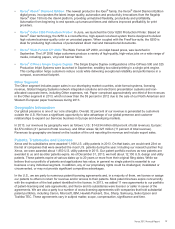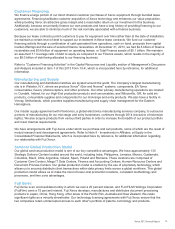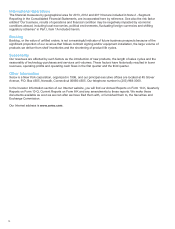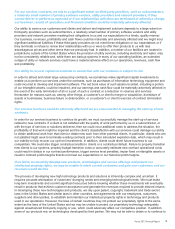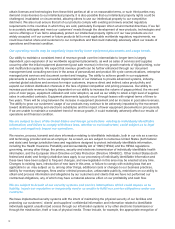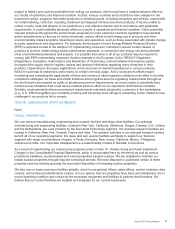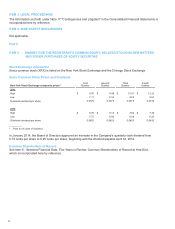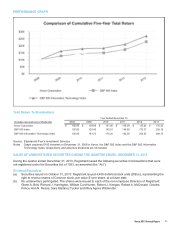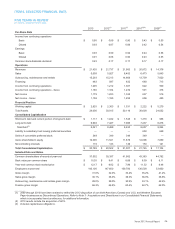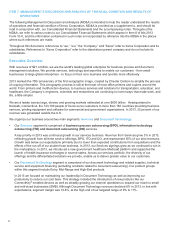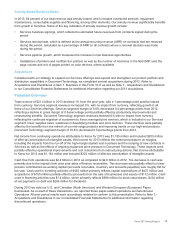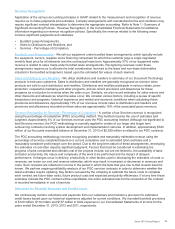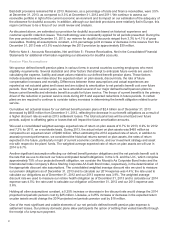Xerox 2013 Annual Report Download - page 38
Download and view the complete annual report
Please find page 38 of the 2013 Xerox annual report below. You can navigate through the pages in the report by either clicking on the pages listed below, or by using the keyword search tool below to find specific information within the annual report.The Credit Facility contains financial maintenance covenants, including maximum leverage (debt for borrowed
money divided by consolidated EBITDA, as defined) and a minimum interest coverage ratio (consolidated EBITDA
divided by consolidated interest expense, as defined). At December 31, 2013, we were in full compliance with the
covenants and other provisions of the Credit Facility. Failure to comply with material provisions or covenants in the
Credit Facility could have a material adverse effect on our liquidity, results of operations and financial condition.
We have outsourced a significant portion of our overall worldwide manufacturing operations and
increasingly are relying on third-party manufacturers, subcontractors and external suppliers.
We have outsourced a significant portion of our overall worldwide manufacturing operations to third parties and
various service providers. To the extent that we rely on third-party manufacturing relationships, we face the risk that
those manufacturers may not be able to develop manufacturing methods appropriate for our products, they may not
be able to quickly respond to changes in customer demand for our products, they may not be able to obtain
supplies and materials necessary for the manufacturing process, they may experience labor shortages and/or
disruptions, manufacturing costs could be higher than planned and the reliability of our products could decline. If
any of these risks were to be realized, and assuming similar third-party manufacturing relationships could not be
established, we could experience interruptions in supply or increases in costs that might result in our being unable
to meet customer demand for our products, damage our relationships with our customers and reduce our market
share, all of which could materially adversely affect our results of operations and financial condition.
In addition, in our services business we may partner with other parties, including software and hardware vendors, to
provide the complex solutions required by our customers. Therefore, our ability to deliver the solutions and provide
the services required by our customers is dependent on our and our partners' ability to meet our customers'
requirements and schedules. If we or our partners fail to deliver services or products as required and on time, our
ability to complete the contract may be adversely affected, which may have an adverse impact on our revenue and
profits.
We need to develop and expand the use of color printing and copying.
Increasing the proportion of pages that are printed in color and transitioning color pages currently produced on
offset devices to Xerox technology represent key growth opportunities. A significant part of our strategy and ultimate
success in this changing market is our ability to develop and market technology that produces color prints and
copies quickly, easily, with high quality and at reduced cost. Our future success in executing on this strategy
depends on our ability to make the investments and commit the necessary resources in this highly competitive
market, as well as the pace of color adoption by our existing and prospective customers. If we are unable to
develop and market advanced and competitive color technologies or the pace of color adoption by our existing and
prospective customers is less than anticipated, or the price of color pages declines at a greater rate and faster pace
than we anticipate, we may be unable to capture these opportunities and it could materially adversely affect our
results of operations and financial condition.
Our business, results of operations and financial condition may be negatively impacted by legal and
regulatory matters.
We have various contingent liabilities that are not reflected on our balance sheet, including those arising as a result
of being involved in a variety of claims, lawsuits, investigations and proceedings concerning: securities law;
governmental entity contracting, servicing and procurement laws; intellectual property law; environmental law;
employment law; the Employee Retirement Income Security Act (ERISA); and other laws and regulations, as
discussed in the “Contingencies” note in the Consolidated Financial Statements. Should developments in any of
these matters cause a change in our determination as to an unfavorable outcome and result in the need to
recognize a material accrual, or should any of these matters result in a final adverse judgment or be settled for
significant amounts, they could have a material adverse effect on our results of operations, cash flows and financial
position in the period or periods in which such change in determination, judgment or settlement occurs.
Our operations and our products are subject to environmental regulations in each of the jurisdictions in which we
conduct our business and sell our products. Some of our manufacturing operations use, and some of our products
contain, substances that are regulated in various jurisdictions. For example, various countries and jurisdictions have
adopted or are expected to adopt restrictions on the types and amounts of chemicals that may be present in
electronic equipment or other items that we use or sell. If we do not comply with applicable rules and regulations in
connection with the use of such substances and the sale of products containing such substances, then we could be
21



